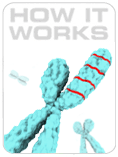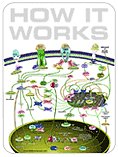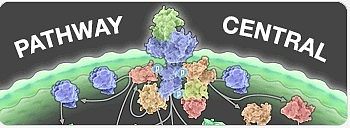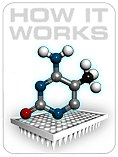
产品详情
文献和实验
相关推荐
服务名称 : 出生缺陷qBiomarker拷贝数PCR芯片
提供商 :SABio
“英拜为您实验加速”
技术服务网址:http://www.yingbio.com/
服务热线:400-696-6643、 18019265738
邮箱:daihp@yingbio.com 、 huizhang1228@foxmail.com
Birth Defects qBiomarker Copy Number PCR Arrays
| Birth Defects qBiomarker Copy Number PCR Arrays(出生缺陷qBiomarker拷贝数PCR芯片) |
| Product | Species | Technology | Cat. No. |
| Birth Defects qBiomarker Copy Number PCR Arrays | Human | Copy Number | VAHS-0510Z |
The qBiomarker Copy Number PCR Arrays are intended for molecular biology applications. This product is not intended for the diagnosis, prevention, or treatment of a disease.
96-well Plate, 384-well (4 × 96) Plate, and 100-well Disc formats are available
人类出生缺陷qBiomarker拷贝数PCR芯片用于研究与人类出生缺陷相关且发生频繁突变的23个基因的拷贝数。许多基因的拷贝数变异都会导致先天性异常。该芯片编码转录因子,细胞表面分子,酶,细胞骨架元件和调节子,以及参与胚胎发育和器官形态发生等调节过程的细胞信号传导分子的基因。这些基因来自主要文献评论和公共数据库中与人类发育生物学相关的最频繁扩增或缺失的基因。这个芯片可做为帮助分类样本的基因型并验证表型生物标记的有效工具来。这个芯片可以使每个基因在每个样本中有四个重复,同时包含一个稳定的多拷贝参考实验,通过适当的DNA插入标准化精确检测拷贝数。简单的产品模式和操作程序让任何一个具备实时定量PCR仪的实验室都可进行常规可靠的拷贝数检测。
qBiomarker拷贝数PCR芯片用于分子生物学应用。本产品不用于疾病的诊断、预防和治疗。
ANKRD11:KBG Syndrome.
CD320:Methylmalonic Aciduria due to Transcobalamin Receptor Defect.
CHD7:CHARGE Syndrome.
CYP21A2:Adrenal Hyperplasia, Congenital.
FOXC2:Lymphedema-Distichiasis Syndrome.
FOXF1:Alveolar Capillary Dysplasia with Misalignment of Pulmonary Veins.
FOXG1:Rett Syndrome.
FOXL2:Blepharophimosis, Epicanthus Inversus, and Ptosis, Types 1 & 2; Premature Ovarian Failure 3.
GALNT11:Congenital Heart Disease with Heterotaxy.
GATA4:Several Congenital Heart Defects.
HNF1B:Diabetes Mellitus, Noninsulin-Dependent; Renal Cysts and Diabetes Syndrome.
IHH:Acrocapitofemoral Dysplasia; Brachydactyly, Type A1.
NEK2:Heterotaxy.
NUP188:Heterotaxy.
PAX2:Optic Nerve Coloboma with Renal Disease; Renal Hypoplasia, Isolated
How it Works
The Copy Number PCR array is a set of optimized real-time PCR primer assays on 96-well, 100-tube or 384-well plates for measuring changes in copy number. The PCR array performs copy number analysis with real-time PCR sensitivity and the multi-loci profiling capability of a microarray. Simply mix the genomic DNA sample with the appropriate ready-to-use PCR master mix, aliquot equal volumes to each well of the same plate, and then run the real-time PCR cycling program. (Download user manual)

| Figure 1: | How Copy Number PCR Arrays Work - Protocol Chart |
The procedure involves isolating genomic DNA (QIAGEN QIAamp DNA Mini Kit or FFPE Tissue Kit is recommended), qPCR detection on qBiomarker Copy Number PCR Arrays or Assays, and data analysis (using the qBiomarker Copy Number Data Analysis). An optional DNA sample quality control step immediately before the detection array or assay setup allows the user to qualify the DNA samples.
To complete the Copy Number PCR Array procedure, start with 400 to1000 nanograms of genomic DNA isolated from fresh tissues, or as low as 800 nanograms of DNA from FFPE sections. Then, mix your DNA with the ready-to-use qBiomarker SYBR Green Mastermixes and aliquot the mixture into each well of the same plate containing pre-dispensed locus-specific primer assays. By performing real-time PCR, the copy number status of a particular sample is determined by comparing the CT values between your test sample and a wild-type control sample (see qBiomarker Copy Number Data Analysis section for detailed principles).
Why qBiomarker Copy Number Arrays?
Guaranteed Performance* - ready-to-use for copy number analysis
Time and cost saving - less than 30 minutes hands-on time for analyzing 23 loci
Ease of data analysis using our easy-to-use Excel-based data analysis template or web-based analysis tool

Layout and Controls: The PCR Arrays are available in both 96-, 384-well plates and 100-well discs and are used to measure the copy number of 23 or 95 genes related to a disease state or pathway. Each gene/locus-specific assay is repeated in technical quadruplicate as indicated in the figure above. As an example, the first gene in the array is measured in wells A1, C1, E1 and G1. The qBiomarker Multicopy Reference Assay (MRef) is used to normalize the data for differences in the amounts of genomic DNA. The Multicopy Reference Assay is shown in purple in the above figure in wells B12, D12, F12, and H12.
You can easily perform a Copy Number PCR Array experiment in your own laboratory, or send your samples to us and take advantage of our PCR Array Services.
*: when using qBiomarker SYBR® Green Mastermix.
Performance Data:
The qBiomarker Copy Number PCR Array System yields a more accurate representation of changes in copy number by using a multi-copy reference assay to normalize the raw target specific data.
qBiomarker Multicopy Reference Assay
The qBiomarker Copy Number Arrays have an integrated multi-copy reference assay for data normalization. The multi-copy reference assay recognizes a stable sequence that appears in the human genome over 60 times, and whose copy number is not affected or minimally affected by local genomic changes. Inclusion of this reference assay during testing allows use of the ΔΔCT method to accurately make copy number calls or relative copy number change calls for specific targets.


| qBiomarker Multicopy Reference Assay is superior to RNase P as a reference assay for copy number determination. Tumor cell line DNA (SKBR3) and reference genomic DNA were mixed in different ratios (100%, 87.5%, 75%, 50%, 25%, 12.5% and 0% SKBR3 cells respectively), and the DNA mixes were tested for GRB7 gene copy number, using either MRef assay or RNaseP assay as the reference. The GRB7 copy number in the reference genomic DNA is assumed to be 2. The "Expected" GRB7 gene copy numbers in 87.5%, 75%, 50%, 25%, 12.5% mixing ratio samples are calculated based on the GRB7 gene copy number in 100% SKBR3 genomic DNA sample, and the mixing ratio between the SKBR3 genomic DNA and Promega genomic DNA. The observed GRB7 gene copy numbers in general agree well with the expected values when using QIAGEN Multi-copy Reference Assay as the reference, while significant differences exist between the observed GRB7 gene copy numbers and the expected values when RNaseP is used as the reference assay. |

RNaseP gene is not suitable as a normalizer of sample input in cancer cell line DNA samples. The absolute average copy numbers of RNaseP per normal genome copy amount of DNA were determined in two breast cancer cell line (SKBR3 and MCF7) genomic DNAs with the delta delta Ct method, using QIAGEN multi-copy reference assay as the normalization control of DNA input. The absolute copy number of RNaseP per normal genome in the genomic DNA is assumed to be 2.
Universal Nature of Multicopy Reference Assay
The complete PCR Array System, with high quality input RNA, is guaranteed to yield single amplicons of the predicted size without primer dimers or other secondary products to ensure the most accurate real-time PCR results possible.

Stable Performance of the Multicopy Reference (MRef) Assay in 129 DNAs from 9 Major Human Populations. The qBiomarker multi-copy reference assay (MRef) and a qBiomarker copy number assay for RB1 were tested against DNAs from 129 healthy individuals from 9 major ethnic populations. Each assay and DNA sample combination was run in quadruple reactions. Delta CT between the average CT of the MRef assay and the RB1 assay was calculated for each individual DNA. The average delta Ct for samples within each ethnic population is plotted. Error bars show the standard deviation of the delta CT within each ethnic population. The RB1 gene is assumed to be present at 2 copies in all healthy individual DNAs.
Application Data
Aneuploidy Study

qBiomarker Copy Number Assays accurately identify aneuploidy. qBiomarker Copy Number Assays designed to target AR and MECP2 were tested against 4 cell line DNAs containing 1 copy (XY, Coriell NA13619), 2 copies (XX, Coriell NA01921), 3 copies (XXX, Coriell NA03623) and 4 copies (XXXX, Coriell NA11226) of X-chromosome. Chromosomal aberrations had been previously identified by cytogenetic methods. A control assay, targeting a stable, multi-copy region in the human genome, was used to normalize the amount of DNA input. ΔΔCT method was used to calculate the gene copy number, using XX (Coriell NA01921) as a 2-copy reference. Each assay was tested against each sample in quadruple replicate reactions, and a t-test was performed.

上海英拜生物科技有限公司
实名认证
钻石会员
入驻年限:13年









